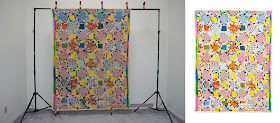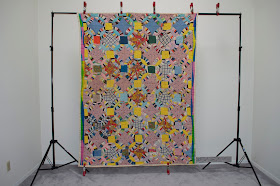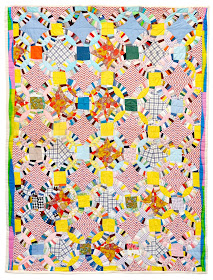 |
| screen shot: background partially removed using clone stamp |
All of my quilt photography is done in house. It's kind of a hobby. I learned to use a camera at a young age and was taking pictures before learning how to read and write. In high school, I learned how to use the darkroom to develop black and white transparencies, negatives, and prints. In college, I studied photography and learned how to do most of the known photographic processes- dye-transfer, platinum printing, cyanotypes, hand-coated emulsions, tintypes, color transparencies and negatives, C-prints and Cibachromes. When the first digital cameras came out, I got one. When Photoshop came out, I taught myself how to use it.
It was really cool to land in the quilt world with this set of skills, because photography is a commodity. But I like taking a do-it-yourself approach to all media, from my web site to self-published books. Here are some pictures showing some of the steps from an original raw image to a usable quilt photo.
 |
| "before" photo set-up and "after" digital correction |
 |
The raw image shows the set-up, with straight-edge clipped to the bottom
edge of the quilt to help it hang straight. I use rubber-tipped A-clamps.
Since I have daylight coming in from above, I use flash to balance the
light. I don't use this set-up for fragile or very old quilts.
|
 |
After the pictures are uploaded to my computer, I open up the raw image
in Photoshop and begin the process of digitally correcting the image. To
cut out the background, I use a tool called "clone-stamp", which replaces
one area with information from another area. In this case, it's plain white.
|
 |
| Usually, I'll clone stamp along the edge and box/select the leftover |
 |
| then hit "delete" |
 |
Clone-stamping a clamp out of the picture is a little trickier, but it's
the same idea. I'm just replacing the information with other info
found elsewhere in the image - easy peasy! Continue it around the whole
perimeter and crop for a full view quilt on a plain white background.
|
 |
clone stamped area along the lower edge, the gray is leftover
background, which will be removed with box/select/delete |
 |
| sectioned-off pieces of remaining background to be cut out |
 |
Done! It's a little light along the top edge, and I can
actually clone stamp a more defined binding edge if
I want, but for now, it's OK
|
So, that's the skinny on the before/after and in-between. There are many other methods that work just as well, if not better. I do not recommend the photo set-up for very old or fragile quilts - too much stress on the fibers. Any way you do it, takes a couple hours per quilt from start to finish.










Thanks! I love your quilt photos. I need to take a class on photoshop...
ReplyDeleteThanks for sharing Bill. You make it all look so easy.
ReplyDelete